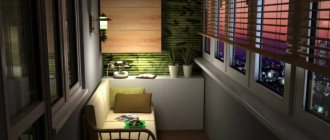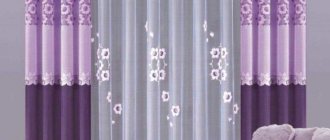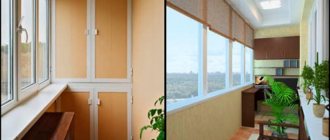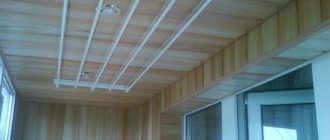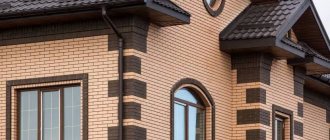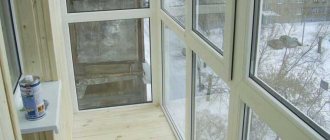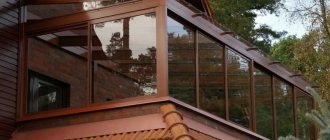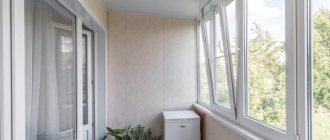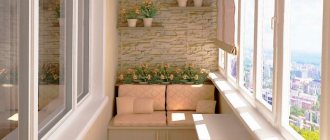People living in city apartments dream of cozy balconies and loggias. The balcony space is very tiny, but it can be stylish - interesting design effects can be realized on the balcony. Now there are a lot of options available that allow you to create a beautiful brick balcony design. The simplest and most effective way to finish brickwork on a loggia is traditional painting. Naturally, it makes sense to carry out any finishing work if the balcony is glazed, and better if it is insulated.
Options for finishing brickwork
When choosing a finishing option, you need to consider whether the balcony is glazed.
For open balconies, paint or varnish is usually used. Ceramic tiles or decorative plaster are less commonly used.
The materials used to cover the walls of closed balconies are more varied. In addition to those listed above, you can use wallpaper or various panels for walls. The most popular is applying paint to the walls.
How to paint a brick wall?
In the process of painting brick walls, it is important to choose the right coloring agent and adhere to the technology of its application.
Choosing paint for brick
The following compositions are suitable for painting brick walls on the open side of the balcony:
- Slaked lime is inexpensive and is suitable for painting walls that are protected from precipitation by awnings and other coverings. Diluted lime is applied to the wall in two or three layers using a brush.
- Water-based paints for exterior use are also used for this purpose. This group includes the following types of dyes: silicate, acrylic, acrylic silicone. The first option will last only 3-5 years, but the next two types can create a protective coating that will last up to 13 years.
Making paint selection
Before you figure out how to paint a brick wall on a balcony, you need to choose a paint, taking into account the type of balcony and the quality of the wall being painted.
When choosing a paint, it is worth studying it:
- compound;
- price;
- wear resistance;
- durability;
- consumption;
- drying time;
- Ease of use;
- adhesive properties;
- UV resistance;
- frost resistance;
- water and vapor permeability.
How did the loft style appear?
“Loft” literally translated from English means “attic,” and this is not at all accidental, since it was in the rooms located on the upper floors of industrial buildings that this direction in interior design appeared. For the first time, the conversion of warehouses and trading floors into housing began to be practiced in the United States in the 30s of the twentieth century during the Great Depression.
The history of the loft style is very revealing and explains many of its specific features.
During this period, a large number of enterprises were closing, and their owners, in order to somehow stay afloat, began to rent out or sell for a small price certain parts of industrial buildings, which quite suited representatives of the art world, who, by purchasing them, immediately received spacious housing and creative workshops.
Not having high incomes, the new owners or tenants were not able to carry out full renovations in the fairly large space of the halls, leaving them in their original appearance with brick walls and massive steel beams supporting the roof. Over time, in the premises of such studio apartments, inexpensive, simple furniture accessories necessary for living and working appeared, which also became an integral part of the design.
Some time passed, and such housing began to gain widespread popularity, even to a certain extent “migrated” to the elite category, and its original design began to be considered a design style, named after the place of its origin.
The loft style has not lost its popularity today, and this trend always has a fairly wide circle of fans. Therefore, when planning to decorate their home in a modern style at minimal cost, many choose the “loft”.
Paint for closed balconies
It is recommended to paint closed balconies with water-based paints.
The connecting components can be:
- Polyvinyl acetate. Inexpensive, UV resistant and tolerates moisture well.
- Latex. It turns yellow in the sun and deteriorates when exposed to low temperatures.
- Acrylic. The best quality option.
The paint should be white. If desired, it can be painted in other colors using pigments. If water-based paint was painted in production, then its quality is very low.
Enclosed areas can be painted with water-based paint. When dry, they do not form harmful substances. There are a lot of shades of this paint. They are diluted with organic solvents.
Emulsion paints can also be used to paint enclosed balconies.
Note!
- Sofa on the balcony: functions and advantages of a sofa on the balcony. Selecting a model, size and shape. DIY instructions (photo + video)
- Decorating a balcony with clapboards - detailed instructions on how to decorate a balcony quickly and beautifully (135 photos)
- Clothes dryer for the balcony - 105 photos of modern models and video instructions for their installation
An alternative to paint is to use clear varnish.
Paint for open balconies
A brick wall on an open-type balcony can be painted using emulsion paint for facade work. Oil paints are not recommended because they take a long time to dry and fade in the sun.
You can treat brick with silicate solutions based on liquid glass. They will protect the walls from destruction. The presence of silicon and aluminum additives will provide the coating with anti-corrosion properties.
Preparing the walls
Before painting a brick balcony, you should prepare the walls:
- Remove old coating.
- Inspect the wall and eliminate defects, chips and cracks.
- Clean the seams, renewing them if necessary.
- Clean the surface from dirt, stains, mold and so on.
- Allow the surface to dry completely.
- Apply a coat of primer.
- Paint the walls.
How to extend the service life of sheathed material
Brick walls and decorative stone masonry are treated with water-repellent compounds that extend their service life and protect against excess moisture.
Metal elements are protected from corrosion by being coated with a primer.
Wooden coverings are treated with antiseptics and hydrophobic compounds that protect against moisture, insects, and mold.
Glazing a balcony or loggia will extend the service life of any finishing materials indoors.
Finishing a balcony without material waste is possible. The main thing is to decide on the stylistic direction, as well as choose the most harmonious looking materials.
Paint application process
High-quality painting will be achieved if you use primer and paint from the same manufacturer. It is recommended to apply two coats of paint. The first one is made thicker. The second is applied only after the first has completely dried.
Note!
- Shelves on the balcony - practical ideas and detailed instructions on how to install and where best to place the shelves (115 photos)
Furniture for balconies - 125 photos and video descriptions of real examples of design of balconies and loggias
Wardrobe on the balcony - features of the wardrobe on the balcony. Advantages and disadvantages. Varieties of cabinet models for balconies. Manufacturing and installation of a cabinet by hand (photo + video)
The paint is applied using a brush or roller. If the area to be painted is very large, you can use a spray gun.
Surfaces located next to the area to be painted are sealed with masking tape, and the floor is covered with oilcloth. The paint is applied starting from the corners, using a brush or roller from top to bottom.
Drywall sheets
The walls are covered with gypsum plasterboard, the top layer is wallpaper.
Wallpaper in room decoration.
Paintable wallpaper. The walls are leveled using plasterboard sheets.
The interior is in light green shades. Painted sheets of drywall in the loggia space.
GKLV is often used in the repair of loggias, despite the fact that the material is fragile, and sheets without finishing cladding quickly lose their original appearance.
The final finishing layer is two types of wallpaper (light gray and stone imitation).
Painted wall surface (at the base of a plasterboard slab).
The reason for its popularity is explained by a number of the following features:
- Drywall sheets are quite easy to install;
- Due to the properties of the material, it is possible to implement various ideas in the interior of the loggia;
- Low price GKLV.
The niches in the room are made using plasterboard, the top layer is paint.
Sheets of plasterboard are used as a basis to create a flat surface - then the surface is decorated with wallpaper or painted.
Drywall covered with wallpaper for painting.
Mini bedroom. Facing the room with gypsum boards, finishing layer – paint.
To install gypsum boards, you must first organize high-quality hydro- and thermal insulation. Thus, fragility will not cause trouble during operation.
The walls of a small nursery are leveled using gypsum boards. The finishing layer is paper wallpaper.
Using stencils
Using the stencil technique, you can paint only part of the wall a certain color.
The correct selection of shades will allow you to disguise defects, while highlighting more advantageous areas.
Artificial aging of brick
Old masonry is characterized by chips, cracks and the absence of some bricks.
Note!
- Window sill on the balcony - functions and advantages of a window sill on the balcony. Types of window sills. Choice of material. Methods of fastening and installation (photo + video)
Decorating a balcony with stone: 145 photos and video description of how to decorate a balcony in a stylish and beautiful way
Living room with a balcony - 115 photos of the best ideas and beautiful combinations of a balcony with a room
For artificial aging, each brick must be treated. They chip randomly. Sandpaper wipes all the bricks.
If desired, the seams are rubbed with moss or earth. To fix the result, cover the wall with a couple of layers of acrylic varnish.
Preparatory stage
It involves very careful work with a spatula and a wire brush in order to remove all dirt and unevenness.
Cracks and holes that may be in the wall must be filled with putty.
Then you choose coarse sandpaper and work the surface very carefully, subsequently sanding it. The seams between the bricks can be puttied if you want a smooth surface.
Pay attention to the quality of the brick from which the wall is laid and the quality of the masonry.
carefully for surface damage. If the surface of the wall is in good condition, in the case when the brickwork is smooth and well executed, then it should not be plastered, but it would be more interesting to use it as a certain structure that will look interesting and decorate your balcony.
Primer of the prepared surface
In the event that there is mold , these places must be treated an alkaline solution, which will not take you much time and will not complicate you, then use an acrylic primer with antibacterial components for priming.
To protect an antibacterial primer for such outdoor work . Using a roller and a brush, you need to carefully prime the wall, including all the seams between the bricks.
In the case when you want to restore the paintwork. The wall must be very carefully cleaned of old paint.
Imitation brickwork
You can imitate brickwork using:
- Wallpaper with a convex pattern. They are fixed to the wall using liquid nails and painted. This type of finishing is considered the cheapest.
- Plastic panels. May be of different sizes.
- Decorative bricks. They are attached to the wall just like tiles.
- Sandwich panels. They are quickly installed and suitable for balconies with any glazing.
How to adapt a room
Even before finishing work begins, you need to think about how you plan to use the room. The furnishings and decoration of the room will depend on the direction of your idea.
- Cabinet. This option is especially suitable for a small loft-style balcony. Installing a multi-tiered desktop and several shelves will create a cozy workplace with good lighting.
- Workshop. One large shelving unit will fit well here and will not take up space from an easel or other creative tools.
- Gym. This option is possible if the space allows you. The presence of furniture and additional decorative details will be superfluous here. We advise you to focus exclusively on the walls and ceiling.
- Rest zone. Here you can not limit the course of your ideas. Install a sofa, a floor pouf, a folding table, hang thick Roman blinds to prevent the sun from blinding your eyes, and make the interior as comfortable as possible for relaxation.
6 photos
[email protected] _klimashevich
[email protected] _klimashevich
[email protected] Profile photo kristinaelegantdesign kristinaelegantdesign
[email protected] _design
[email protected] _elizaveta
[email protected] _elizaveta
- Balconies and loggias
You've never seen anything like this before: 9 cool ideas for small loggias
Decorative plaster
To decorate a brick balcony that is not heated, you should use special plaster for facades. A huge selection of types and colors of plaster allows you to obtain surfaces of various colors and textures.
Using lime plaster, brickwork is often imitated.
The plastered wall can be painted in any color.
The standing plaster improves the sound and heat insulation characteristics of the surface. The disadvantage of this coating is increased staticity. Because of this, dirt and dust become clogged in uneven surfaces.
Aftercare
Painted brickwork on the balcony requires regular cleaning to remove stains, dirt and grease.
- To protect against emerging plaque and severe contamination, the wall should be additionally treated with protective agents or a special water-based varnish, which will also provide the painted brick with a more presentable appearance and a long service life.
- But no matter how strong the paint and varnish materials used, the wall will have to be repainted from time to time, since salt deposits inside the brick have a negative effect on the finishing layer.
Remember that it will not be possible to get rid of the finishing layer and return the brick to its original appearance. But even if you change your mind about painting a brick wall, deciding to preserve its natural appearance, do not give up transparent protective coatings, oils and impregnations. They will refresh the look of the brick and allow it to last longer.
Painting walls after plastering
Applying plaster before painting allows you to mask unwanted surface irregularities and defects.
The mills are treated with a mixture of sand and cement. You can strengthen the surface of a glazed balcony using a layer of gypsum without cement.
After drying, a layer of primer is applied to the walls, and then painted. Before applying a new layer, the previous one must dry completely.
Clinker tiles
Clinker tiles are ideal for finishing open balconies. It can be laid not only on walls, but also on the floor. The material has high wear resistance and can withstand winter frosts well.
The disadvantage of tiles is low thermal conductivity. It cools quickly, so it is not comfortable to touch it in the cold season.
From the photos of brick balconies it is obvious that various materials can be used to decorate them. The most popular option is to paint the walls.
It allows you to improve the appearance of the surface and protect the surface from mechanical damage and adverse weather conditions.
Joining
This method is used when, during the finishing of painting work, the structure of the brick and masonry seams stand out. For jointing, a copper or steel tube is used - its diameter is at least 1 cm. When the masonry is finished, the mason passes this tube along all the remaining seams - this ensures concave or convex reliefs, removes excess layers of concrete and at the same time preserves the brightness and beauty of the design.
Related article: Arranging a kitchen on the balcony: preparation and remodeling
If the design of finishing bricks on a balcony requires highlighting each brick, then the seams between the bricks are painted with a different shade of the selected color. If the loggia consists of silicate or finishing bricks, then there is no need for preliminary preparation for such a surface, however, this is true for latex paints.
